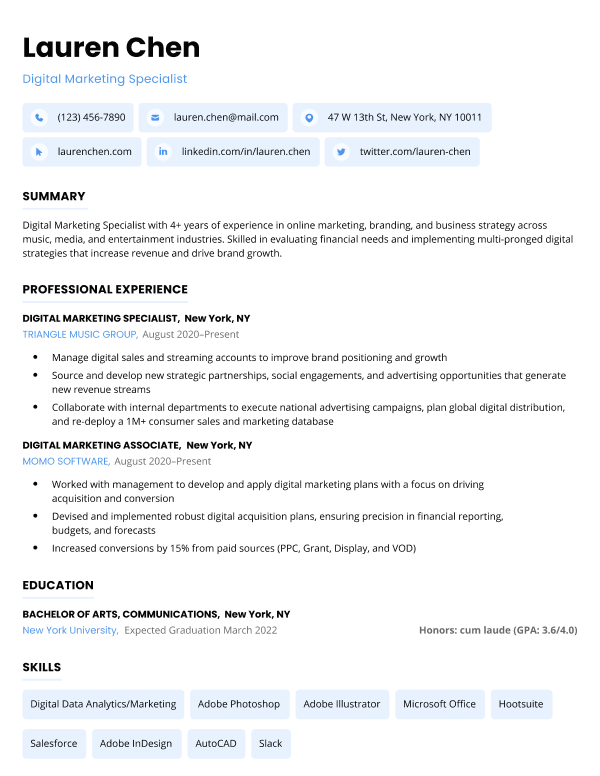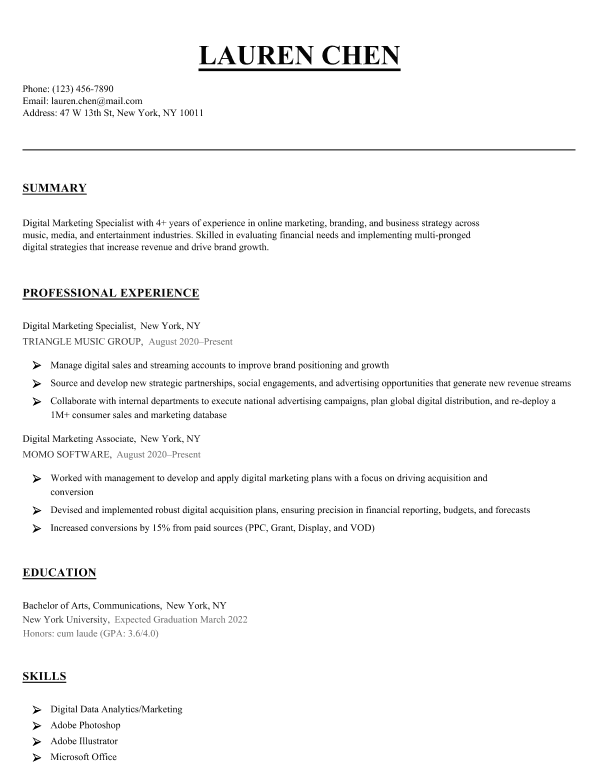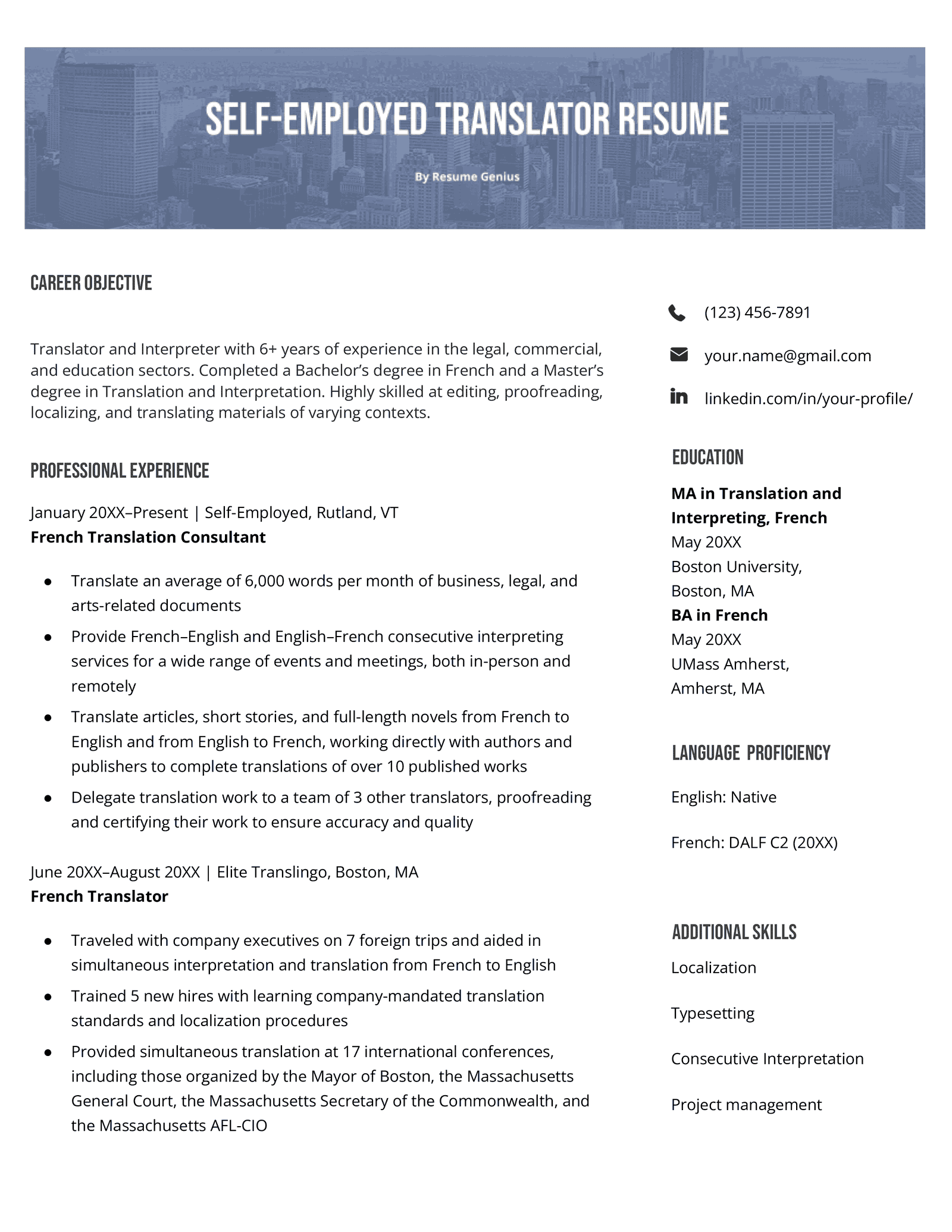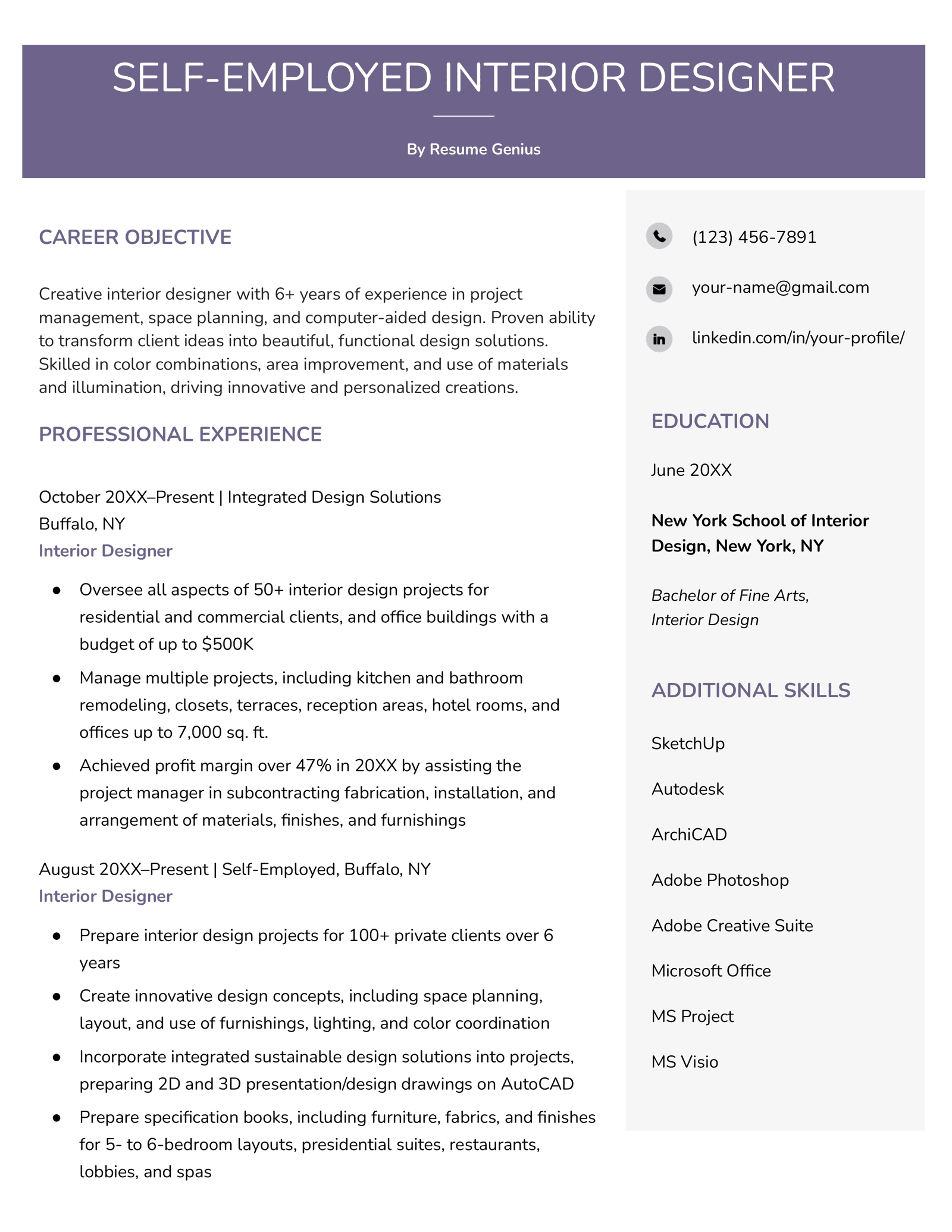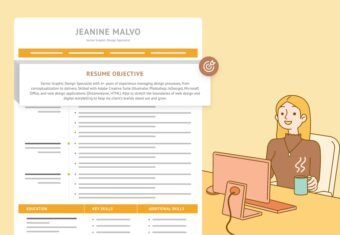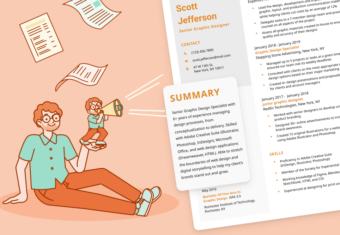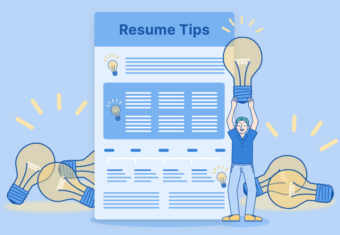Self-employment experience can make a valuable addition to your resume. In this article, we’ll show you how to include full-time self-employment and part-time (or freelance) self-employment on your resume, as well as what to consider when deciding whether or not to include it.
List full-time self-employment on your resume
If you’ve been working full-time in a self-employed capacity, simply list it on your resume like you’d include a traditional job in your work experience section.
Our free-to-use resume builder can make you a resume in as little as 5 minutes. Just pick the template you want, and our software will format everything for you.
Choose the right job title for your self-employed work
It’s important to highlight how your self-employment makes you qualified for your target role. One way to do this is by adjusting the job title on your resume so it mirrors the language from the job description — but make sure the title you choose is clear and accurate.
For example, if you’re applying for an entry-level position, listing yourself as “Founder, General Manager, and CEO” of your own dog-walking business might make employers hesitant to hire you. When your resume makes you look overqualified for a position, employers are likely to wonder why you’re applying and whether you’ll be committed to the role.
In this case, it would be better to list yourself as “dog-walker” at “self-employed,” and highlight the skills and accomplishments that are directly relevant to the entry-level position you’re applying for.
Decide what to put in the company name field
When you fill out the company name on your resume, you have several options (even as a freelance writer):
- Write Self-Employed, Freelancer, or Contractor
- List your company’s name (for example, if you registered one for tax purposes)
- If you did the bulk of your projects for one company, you can list that company’s name (or a few company names)
Here’s how each of those options would look:
Front-End Developer
Self-Employed, London, UK
August 20XX—Present
Window Cleaner
Aaron Chen Window Cleaning Services, Victoria, BC
August 20XX—Present
Translator/Interpreter
NMT INC./ABQ Translations/APD, Albuquerque, NM
August 20XX—Present
If you worked with any well-known companies, you can also fit that information into your work experience bullet points. For example:
- Translated over 250 sentences from Traditional Chinese to English for Meta, as part of their AI Hokkien voice translator project
Include relevant skills for a self-employed resume
It’s best if you can frame your period of self-employment in a way that demonstrates your continued professional development. One way to do this is by highlighting any transferable skills you gained, with an emphasis on industry-specific hard skills:
- Gained PCAP certification in Python programming language through independent study and online courses
- Completed online management training courses covering topics such as project planning, team leadership, and stakeholder management
You can also include soft skills like communication and time management:
- Developed empathy and active listening skills by regularly interacting with current and prospective clients, discussing their needs and responding to complaints
During your self-employment, you probably learned a lot of valuable skills that’ll make you an asset to any company. Here are a few key skills you can highlight on your resume to stand out:
Interpersonal skills
- Client relationship management
- Networking
- Communication skills
Interpersonal skills involve interactions with clients and colleagues. Highlight specific examples, like client testimonials, events, or presentations.
Professional skills
- Adaptability
- Problem-solving
- Time management
These are skills that can help you succeed in most professional settings. Provide examples of how you used them to resolve complex issues, meet deadlines, and deal with workplace changes.
Entrepreneurial skills
- Financial management
- Marketing and branding
These skills are especially desirable for leadership roles. Emphasize your experience managing budgets, driving revenue growth, and attracting customers through branding.
It’s also important to include skills that are specific to the job or industry you’re applying for. Show your expertise in the software and technologies commonly used in your field, and if you’re aiming for a remote or hybrid role, be sure to demonstrate your proficiency in collaboration tools such as Slack, Zoom, or Trello.
Example of a full-time self-employed resume
In this example resume, the applicant has been self-employed for several years and is now applying for a full-time position at a company with the intention of ending their self-employment:
Example of a full-time self-employed resume
SELF-EMPLOYED TRANSLATOR
CONTACT INFORMATION
Your Name
(123) 456-7891
your.name@gmail.com
linkedin.com.in/your-profile
CAREER OBJECTIVE
Translator and Interpreter with 6+ years of experience in the legal, commercial, and education sectors. Completed a Bachelor’s degree in French and a Master’s degree in Translation and Interpretation. Highly skilled at editing, proofreading, localizing, and translating materials of varying contexts.
PROFESSIONAL EXPERIENCE
January 20XX–Present | Self-Employed, Rutland, VT
French Translation Consultant
- Translate an average of 6,000 words per month of business, legal, and arts-related documents
- Provide French–English and English–French consecutive interpreting services for a wide range of events and meetings, both in-person and remotely
- Translate articles, short stories, and full-length novels from French to English and from English to French, working directly with authors and publishers to complete translations of over 10 published works
- Delegate translation work to a team of 3 other translators, proofreading and certifying their work to ensure accuracy and quality
June 20XX–August 20XX | Elite Translingo, Boston, MA
French Translator
- Traveled with company executives on 7 foreign trips and aided in simultaneous interpretation and translation from French to English
- Trained 5 new hires with learning company-mandated translation standards and localization procedures
- Provided simultaneous translation at 17 international conferences, including those organized by the Mayor of Boston, the Massachusetts General Court, the Massachusetts Secretary of the Commonwealth, and the Massachusetts AFL-CIO
EDUCATION
MA in Translation and Interpreting, French
May 20XX
Boston University,
Boston, MA
BA in French
May 20XX
UMass Amherst,
Amherst, MA
LANGUAGE PROFICIENCY
English: Native
French: DALF C2 (20XX)
ADDITIONAL SKILLS
Localization
Typesetting
Consecutive Interpretation
Project management
List part-time self-employment on your resume
Putting freelance projects on your resume is simple — when you format your resume, list two positions and make it clear from the dates that both roles continue to the present.
Digital Marketing Specialist
Kenting Software | Kenosha, WI
July 20XX–present
- Create 5+ blog posts per week on software updates
- Manage 7-person team
- Increased CTR by 47% in 12-month period by implementing new marketing strategies
- Use 5+ SEO tools, including Ahrefs, SEMrush, and Google Analytics, to analyze user needs
Content Creator
Self-Employed | Kenosha, WI
December 20XX–present
- Write an average of 10 blog articles per month on travel for Wandering Around the Midwest, Roaming Alone, and Travel with Pets — Unleashed
- Produce 1,500+ word articles with turnaround time as tight as 3 days
- Earned average of 20% in bonuses in 2021 due to travelers mentioning my articles at travel destinations for discounts
- Increased output by 27% from 2019 to 2021
Because both of these positions are roles the applicant currently holds, they can list whichever job is more relevant to the opening they’re applying for.
For example, if this hypothetical applicant applies to a software company, they can list the Digital Marketing Specialist role first. Or, if they’re applying for a full-time travel blogging role, they can list the Content Creator role first instead
You can also use your cover letter to describe how you succeeded at balancing a full-time job and self-employment at the same time!
Example of a part-time self-employed resume
This resume example was written by a candidate who currently has a full-time job but does regular freelance work:
Example of a part-time self-employed resume
SELF-EMPLOYED INTERIOR DESIGNER
CONTACT INFORMATION
Your Name
(123) 456-7891
your.name@gmail.com
linkedin.com.in/your-profile
CAREER OBJECTIVE
Creative interior designer with 6+ years of experience in project management, space planning, and computer-aided design. Proven ability to transform client ideas into beautiful, functional design solutions. Skilled in color combinations, area improvement, and use of materials and illumination, driving innovative and personalized creations.
PROFESSIONAL EXPERIENCE
October 20XX–Present | Integrated Design Solutions
Buffalo, NY
Interior Designer
- Oversee all aspects of 50+ interior design projects for residential and commercial clients, and office buildings with a budget of up to $500K
- Manage multiple projects, including kitchen and bathroom remodeling, closets, terraces, reception areas, hotel rooms, and offices up to 7,000 sq. ft.
- Achieved profit margin over 47% in 20XX by assisting the project manager in subcontracting fabrication, installation, and arrangement of materials, finishes, and furnishings
August 20XX–Present | Self-Employed, Buffalo, NY
Interior Designer
- Prepare interior design projects for 100+ private clients over 6 years
- Create innovative design concepts, including space planning, layout, and use of furnishings, lighting, and color coordination
- Incorporate integrated sustainable design solutions into projects, preparing 2D and 3D presentation/design drawings on AutoCAD
- Prepare specification books, including furniture, fabrics, and finishes for 5- to 6-bedroom layouts, presidential suites, restaurants, lobbies, and spas
EDUCATION
Bachelor of Fine Arts, Interior Design
June 20XX
New York School of Interior Design,
New York, NY
ADDITIONAL SKILLS
- SketchUp
- Autodesk
- ArchiCAD
- Adobe Photoshop
- Adobe Creative Suite
- Microsoft Office
- MS Project
- MS Visio
Decide whether or not to list self-employment on your resume
Self-employment is a broad term that includes many different kinds of work, from freelancing and independent contracting to starting your own business.
Whether you’re listing full-time or part-time work on your resume, the decision to include self-employed experience on your resume depends on how relevant it is to your target role. Here are some guidelines:
When to include self-employment on your resume
As a general rule, you should include your self-employment on your resume when the experience is relevant to the job you’re applying for.
If you were self-employed between jobs, including this experience can address any career gaps and demonstrate continued professional development.
When your self-employed work is directly related to the position you’re applying for, helps you explain a period of unemployment, or represents tangible skills and achievements, you should include it.
When to leave self-employment off your resume
If your self-employment:
- is unrelated to the job you’re currently applying for, or
- doesn’t help you demonstrate relevant skills and qualifications,
then you can choose not to include it on your resume.
For example, if you’re applying for a product manager position at a hardware company, you can leave your guitar teacher side-hustle off your resume, since it doesn’t tell employers anything about your abilities as a product manager.
You can also choose not to include self-employed experience if your resume is too long and there are other positions you want to prioritize.
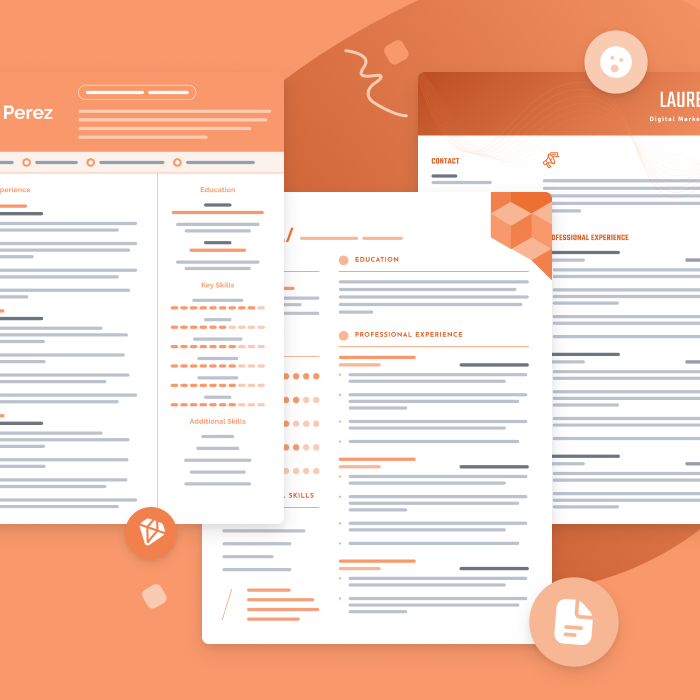
The best resume templates for 2024
One of the best ways to make your resume is by filling out one of our free resume templates. All our templates are designed by experts and free to download for Microsoft Word or Google Docs.
Click to rate this article
4.7 Average rating



